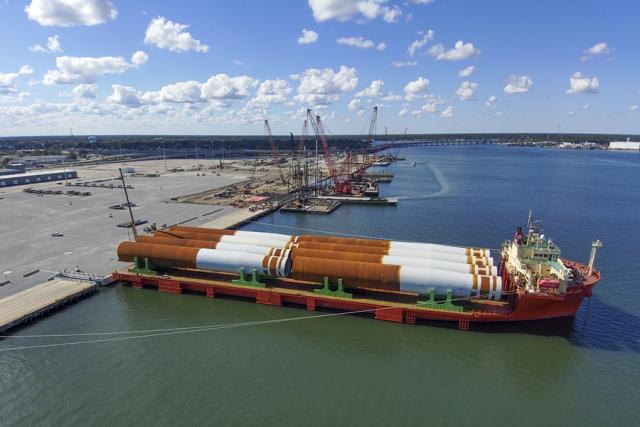
The first eight monopile foundations for Coastal Virginia Offshore Wind were recently offloaded at the Portsmouth Marine Terminal. Dominion Energy says the 2.6-gigawatt project will provide carbon-free energy for up to 660,000 customers at peak output. (Source: Dominion Energy)
The U.S. Bureau of Ocean Energy Management has approved Dominion Energy’s 2.6-gigawatt (GW) Coastal Virginia Offshore Wind project, the largest of five commercial offshore wind developments approved by the U.S. to date, the agency said on Oct. 31.
Capable of powering more than 900,000 homes, the project will include 176 wind turbine generators, each with a capacity of 14.7 megawatts, and three offshore substations. Construction is expected to be complete in 2026, helping move the U.S. closer to its goal of deploying 30 GW of offshore wind capacity by 2030.
“Today’s approval of the largest offshore wind project in U.S. history builds on the undeniable momentum we are seeing,” Secretary of the Interior Deb Haaland said in a statement. “Together with the labor community, industry, Tribes and partners from coast to coast, we are aggressively working toward our clean energy goals.”
Dominion Energy said construction for the project, which is on time and on budget, is scheduled to begin later this year. The first eight monopile foundations were recently offloaded at the Portsmouth Marine Terminal.
“Receiving a favorable Record of Decision from the Bureau of Ocean Energy Management is a monumental achievement for Dominion Energy and the Coastal Virginia Offshore Wind team. More than a decade of work has gone into the development, design and permitting of CVOW,” Dominion Energy CEO Bob Blue said. “Offshore wind is a vital part of our strategy to provide our customers with a diverse fuel mix that delivers reliable, affordable and increasingly clean energy.”
The latest approval follows the approval of Vineyard Wind 1 offshore Massachusetts, South Fork Wind offshore New York, Ocean Wind 1 offshore New Jersey and Revolution Wind offshore Rhode Island. BOEM said the projects will collectively add more than 5 GW of renewable energy to U.S. grids, providing enough to power more than 1.75 million homes.
The bureau said it is on track to complete reviews of at least 16 offshore wind energy project plans by 2025. Together, the projects represent more than 27 GW of clean energy.
Recommended Reading
Plug Power CEO Sees Hydrogen as Part of US Energy Dominance
2025-01-29 - Plug Power CEO Andy Marsh says the U.S., with renewable energy resources, should be the world’s leading exporter of hydrogen as it competes globally, including with China.
Energy Transition in Motion (Week of Jan. 17, 2025)
2025-01-17 - Here is a look at some of this week’s renewable energy news, including more than $8 billion more in loans closed by the Department of Energy’s Loan Programs Office.
Gulf Coast, Midwest Hydrogen Hubs Land up to $2.2B in DOE Funding
2024-11-20 - The funding, awarded by the Department of Energy, is part of up to $7 billion the U.S. allocated to establish hydrogen hubs across the country.
Air Liquide, TotalEnergies Partner to Produce Hydrogen
2024-11-25 - The hydrogen will be produced and used at Air Liquide and TotalEnergies' La Mède biorefinery in France to produce biodiesel and sustainable aviation fuel.
US Hydrogen Concerns Linger as Next Administration Nears White House
2024-12-11 - BP, EDP Renewables, Inpex and Plug Power executives discuss the state of hydrogen and the hydrogen production tax credit.
Comments
Add new comment
This conversation is moderated according to Hart Energy community rules. Please read the rules before joining the discussion. If you’re experiencing any technical problems, please contact our customer care team.





